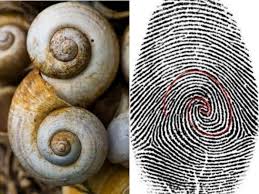
Mathematician Arthur Benjamin said, “Mathematics is the science of patterns, and we study it to learn how to think logically, critically, and creatively.”
Not only do patterns exist in nature, they are clearly ubiquitous. Mandelbrot’s fractals (often called the thumbprint of God) are but one example of a mathematical pattern repeated on a scale ranging from the micro world to the cosmos. Another extraordinary pattern is known as the Fibonacci sequence, which graphically translates into Fibonacci’s spirals (often referred to as the fingerprints of God.)
Leonardo Bonacci (a.k.a. Leonardo of Pisa and Fibonacci) was an Italian mathematician most famous for his discovery of what has been called the “golden sequence” of numbers. The famous Fibonacci sequence is simply the following, repeated to infinity. The next number in the sequence is always the sum of the previous two numbers:
0, 1, 1, 2, 3, 5, 8, 13, 21, 34, 55, 89, 144, 233, 377, 610, 987, 1597, 2584, 4181…
This reasonably short video demonstrates how the pattern can be found  everywhere from DNA to clouds in the sky. This slightly longer documentary claims to find the golden sequence everywhere in nature, art, music, and even the Mandelbrot set.
everywhere from DNA to clouds in the sky. This slightly longer documentary claims to find the golden sequence everywhere in nature, art, music, and even the Mandelbrot set.
Of course, not everyone agrees with mathematicians who claim the Fibonacci sequence can be found in virtually everything in the universe. For example, physicist Donald Simanek offers harsh criticism of Fibonacci on a page at his website called the “Fibonacci Flim-Flam.”
Professor Simanek described people (like me) who found the pro-Fibonacci video interesting as “the lunatic fringe who look for mysticism in numbers.” However, he is mistaken to assume that I have any sort of unusual fascination with numerology — I don’t even play the lottery except on the rare occasion that my wife asks me to buy her a ticket, and I don’t think that counts.
I’ve always relied on hard work, not luck, to earn income. I seriously doubt I could plot a Fibonacci spiral on graph paper myself — even if my life depended on it. In other words, I’m really not qualified to arbitrate the dispute between a physicist and all of these mathematicians. My choice to accept the consensus of math experts over the dissenting opinion of the physicist may very well be an example of the bandwagon fallacy, no different than belief in global warming.
If you assume that I’m an ordinary person who watches a few YouTube videos (yes, Fibonacci merited several) and accepts everything there on face value, you’d be wrong — I watch a lot of videos. Also, Google the name “Fibonacci” and just about every link on the first page or two talks about how important Leonardo Bonacci was. The guy is allegedly responsible for getting replacing Roman numerals with Arabic symbols, which makes him a hero in my book. Can you imagine trying to work through calculus problems using Roman numerals?
It appears inarguable that some sort of pattern can be found in every created thing. We may see the effect, but don’t seem to understand the cause.
 Some people will assert that these patterns are governed by the laws of mathematics, which is a fine argument until you realize these laws of mathematics must have existed prior to the universe and origin of matter, which is irrational. Mathematics is the study of quantity, structure, space, and change — how can we study something before it exists?
Some people will assert that these patterns are governed by the laws of mathematics, which is a fine argument until you realize these laws of mathematics must have existed prior to the universe and origin of matter, which is irrational. Mathematics is the study of quantity, structure, space, and change — how can we study something before it exists?
Nor can the so-called “laws of physics” begin to explain how (or why) a universe could come from nothing because of complex order when nothing existed?
Patterns can be found in grains of sand and living cells, as well as galaxies in the cosmos — and according to the mathematicians, all of them bear these spectacular “fingerprints of God” known as Fibonacci’s spirals.
God’s plan for nature is complex and delicate, as this beautiful video about the reintroduction of wolves into Yellowstone National Park illustrates. The restoration of a missing link in the food chain literally changed the landscape.
Which brings this question to mind: can design exist, without a Designer?

Its way too much for my head